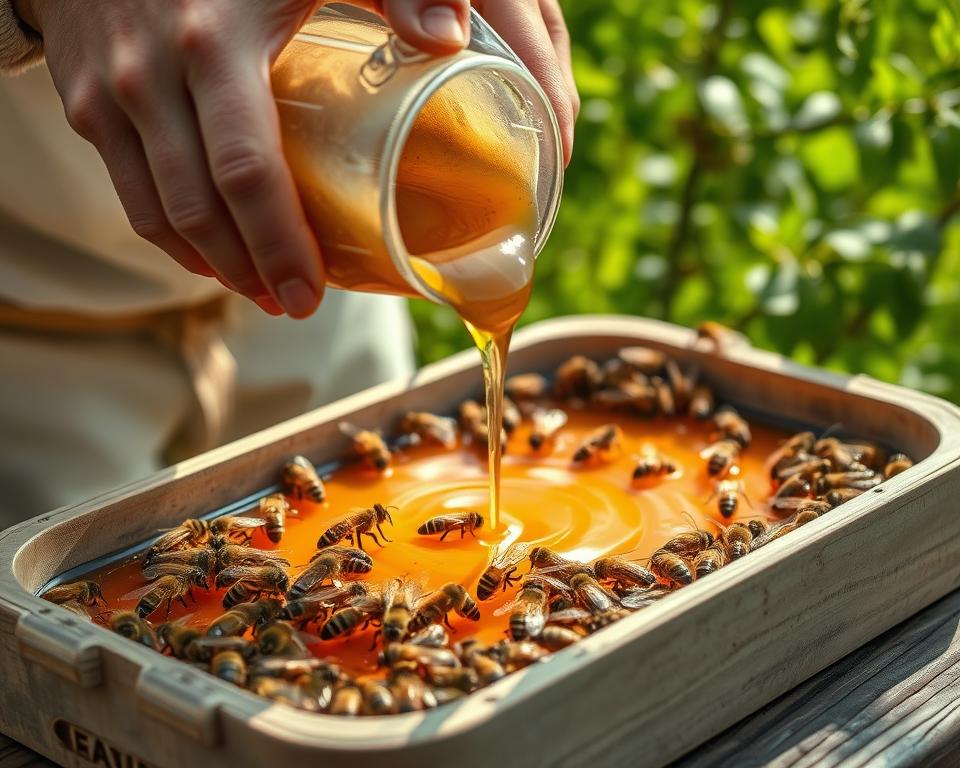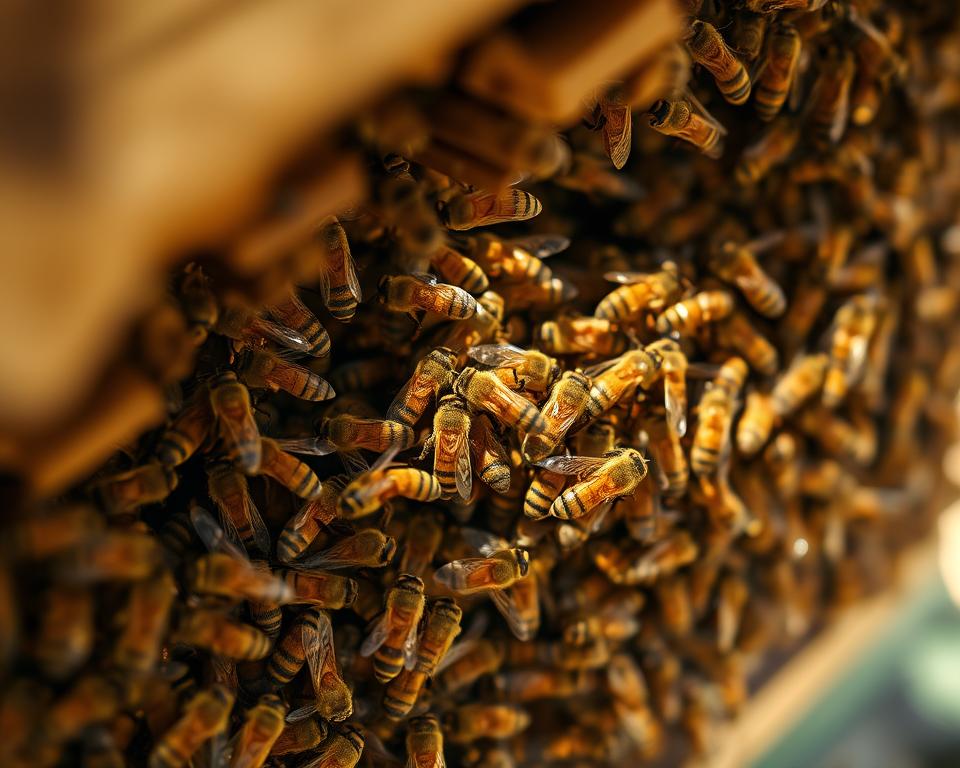As a beekeeper, you know how key it is to keep your colony healthy and productive. Giving your bees the right food is essential, more so when there’s little natural nectar around.
Nectar scarcity can really hurt your colony’s health. So, feeding them sugar syrup is a smart move. It helps meet their nutritional needs.
In this guide, I’ll show you how to make sugar syrup for your colony. You’ll learn when it’s needed and how to spot signs of hunger.
Key Takeaways
- Understand the importance of supplemental nutrition for your colony.
- Learn how to prepare sugar syrup for your bees.
- Recognize the signs of starvation in your colony.
- Discover best practices for beekeeping and nutrition.
- Improve your colony’s health and productivity.
Understanding the Need for Sugar Syrup
Sugar syrup is key for bees when flowers are scarce. As a beekeeper, knowing when to give it is vital for your colony’s health.
Why Bees Require Sugar Syrup
Bees need sugar syrup as a backup to their natural food. It gives them carbs for energy when nectar is hard to find. It’s very important in early spring or late fall when nectar is scarce.
Beekeeping experts say sugar syrup can save colonies struggling to find nectar. It’s a common way to keep colonies healthy and strong.
Seasonal Considerations for Feeding
When to feed sugar syrup depends on the season. In early spring, it boosts colony growth by giving energy for new bees. In late fall, it prepares them for winter by storing energy.
- In spring, sugar syrup helps colonies grow.
- In fall, it gets them ready for winter.
- In summer, it’s not needed if there are lots of flowers.
Knowing these seasonal needs helps beekeepers decide when to feed. This supports the colony’s health and productivity.
Different Types of Sugar Syrup
Knowing the different sugar syrups is key for beekeeping. Choosing the right syrup can greatly help your bees’ health and work.
1:1 Sugar Syrup
The 1:1 syrup mixes equal parts sugar and water. It’s thinner and easier for bees to eat. This is perfect for spring and summer when bees are busy growing their colonies.
Using 1:1 syrup in warmer months boosts brood production. It also helps the bee population grow. It’s a good way to help when nectar is scarce.
2:1 Sugar Syrup
2:1 syrup has two parts sugar to one part water. It’s thicker and more concentrated. Beekeepers use it in fall to get bees ready for winter.
The 2:1 syrup gives bees a rich energy source for winter. This is important because bees are less active in cold weather. It helps them survive the winter.
Other Sugar Variants
Beekeepers also try different ratios and additives. Some use 3:1 or 4:1 syrups for special needs.
“The key to successful beekeeping is understanding the needs of your bees and adapting your practices.”
There are also medicated syrups or those with extra supplements. It’s important to know what you’re doing before trying new things.
| Type of Syrup | Sugar:Water Ratio | Best Used |
|---|---|---|
| 1:1 Sugar Syrup | 1:1 | Spring/Summer |
| 2:1 Sugar Syrup | 2:1 | Fall/Winter Preparation |
| Other Variants | Varies (e.g., 3:1, 4:1) | Specific Needs or Conditions |
By picking the right sugar syrup, beekeepers help their bees thrive. This supports pollinator conservation efforts.
Preparing Sugar Syrup for Bees
Making sugar syrup for your bees is easy. It’s important to prepare it right so your bees get the nutrients they need.
Measuring Ingredients
First, measure your ingredients carefully. The usual sugar syrup mix is 1:1 or 2:1 (sugar:water). For a 1:1 mix, use equal weights of sugar and water. For example, 1 pound of sugar needs 1 pound of water.
Accurate measurement is key to making sure the syrup works well and is safe for your bees.
| Sugar (lbs) | Water (lbs) | Ratio |
|---|---|---|
| 1 | 1 | 1:1 |
| 2 | 1 | 2:1 |
Heating Techniques
After measuring, mix the sugar and water in a saucepan. Heat it over medium, stirring until the sugar dissolves. Don’t boil it too hard, as it can crystallize or create harmful compounds.
Cooling Process
Once the sugar dissolves, take the syrup off the heat. Let it cool down. This is important because hot syrup can harm bees.
Cooling the syrup makes it safer for bees and protects the hive from damage.
How to Feed Bees Sugar Syrup
Feeding sugar syrup to your bees is a careful process. It requires the right tools and timing. As a beekeeper, knowing how to feed sugar syrup is key to keeping your bees healthy and productive.
Best Practices for Application
When you feed sugar syrup, follow best practices to avoid mess and ensure the bees eat it well. Use clean tools and don’t spill syrup to keep pests away. For more tips, check out best practices for feeding bees with sugar.
Feeding Equipment Overview
The right tools are essential for feeding sugar syrup to your bees. You’ll need feeders that can go inside or outside the hive. Internal feeders are safer and easier to use, while external ones are simpler to manage and check.
| Feeder Type | Description | Advantages |
|---|---|---|
| Internal Feeder | Placed inside the hive | Reduces robbing risk, convenient |
| External Feeder | Placed outside the hive | Easier to inspect, manage |
Timing Your Feedings
Timing is everything when feeding sugar syrup to your bees. They need extra food in early spring or late fall when there’s less nectar. Watch your hive and the local nectar flow to figure out when to feed.
Key Considerations:
- Check local nectar flow
- Monitor hive condition
- Feed during scarcity
Recognizing Signs of Starvation in Bees
Spotting starvation signs in your bee colony is key to saving your bees. As a beekeeper, watching your bees’ health is vital, more so when food is hard to find.
Behavioral Indicators
Starving bees change how they act. Look out for:
- Less activity around the hive
- Being more aggressive when food is scarce
- Fewer bees going out to forage
These signs can mean your bees are not eating enough.
Physical Signs
Physical signs of hunger in bees are clear too. Watch for:
- Bees looking discolored or wasted
- Less baby bees being born
- Honeycomb cells that are almost empty
These signs show your bees are struggling to find food.
Importance of Timely Intervention
Acting fast is key when you see starvation signs. Giving sugar syrup can be a big help. It gives your bees the energy they need until they can find natural food again.
Acting quickly saves your bees from starving and keeps your colony healthy.
By being quick to respond to your bees’ needs, you help them stay healthy and strong.
The Benefits of Feeding Sugar Syrup
Feeding sugar syrup to bees has many benefits. It boosts their energy, helps the hive grow, and increases honey production. As a beekeeper, knowing these benefits is key to a healthy colony.

Energy Source for Bees
Sugar syrup is a vital energy source for bees when nectar is hard to find. Beekeepers give it to ensure bees have enough energy. This is important for their daily tasks and colony health.
Boosting bee energy is vital during low nectar times. It stops starvation and keeps the colony active. Healthy bees are better at pollinating and keeping ecosystems balanced.
Supporting Hive Development
Feeding sugar syrup also helps the hive grow. A well-fed colony grows stronger, with a healthy queen and workers.
By feeding sugar syrup, beekeepers help their colonies grow. This leads to more honey and a healthier hive.
Enhancing Honey Production
Feeding sugar syrup also enhances honey production. It might seem odd to feed bees sugar when making honey. But, a healthy colony makes better honey.
By giving bees a steady food source, beekeepers can optimize honey production. This is a big benefit of feeding bees sugar syrup.
Potential Risks of Sugar Syrup Feeding
Sugar syrup is great for bees, but it has some downsides. Beekeepers need to know these risks to handle them well.
Overfeeding Concerns
Feeding too much sugar syrup can cause problems. It might upset the hive’s balance. This could lead to diseases or parasites because the bees are stressed.
Signs of Overfeeding:
- Too many bees outside the hive
- Bees are more likely to get sick
- The syrup might ferment inside the hive
Pesticide Residue Issues
The sugar used for syrup must be clean. Sugar with pesticide residues can harm or kill bees. It’s important to use pure sugar.
Precautions to Avoid Pesticide Residue:
- Buy sugar from trusted sources
- Don’t use sugar near pesticides
- Check your sugar for contamination often
Impact on Honey Taste
Feeding sugar syrup can change honey’s taste. While it’s used when nectar is scarce, too much can make honey taste bad or be too watery.
Maintaining Honey Quality:
| Practice | Benefit |
|---|---|
| Monitor nectar flow | Adjust syrup feeding based on nectar |
| Use the right syrup ratio | Guarantees enough food without diluting honey |
| Regular hive checks | Spot issues early with syrup feeding |
Alternatives to Sugar Syrup
Exploring different options for your bees’ diet can make your hive healthier. Sugar syrup is common, but there are better ways to feed your bees. These alternatives can help your bees stay balanced and healthy.
Natural Sugar Sources
Beekeepers can use natural sugars instead of sugar syrup. For example, honey from other colonies or inverted sugar from honey can be great. “Natural products help mimic their natural world,” says a famous beekeeper. Inverted sugar is easy for bees to digest and helps when nectar is scarce.
Pollen Supplements
Pollen supplements are also key for a balanced diet. Pollen is full of proteins and nutrients that bees need. Beekeepers can give pollen in patties or powder. High-quality pollen supplements are very helpful in early spring when pollen is hard to find.
Flowering Plant Resources
Offering your bees many flowering plants is another smart move. Planting a variety of flowers that have lots of nectar and pollen is good. This not only feeds your bees but also helps the whole ecosystem. Plant flowers that bloom at different times to keep resources flowing all season.
Using these alternatives can make your bee colony stronger and more resilient. As beekeepers, we need to be flexible and meet our bees’ changing needs. “A diverse diet is essential for a thriving hive,” says an expert.
Monitoring Your Hive’s Response
To make sure your bees get the most from sugar syrup, watch their behavior and the hive’s state closely. It’s key to check how your bees react to sugar syrup. This helps you tweak your beekeeping methods.
Observing Bee Activity
Watching bee activity is a main way to see how your hive is doing. Healthy bees are busy, flying in and out, and doing their usual tasks. Look for signs of vigorous activity, like a constant flow of bees in and out.
If bee activity drops or they seem to be struggling, it might mean the syrup isn’t enough. Or, there could be another problem in the hive.

Evaluating Brood Development
Checking on brood health is also important. A strong brood shows a colony is doing well. Check for a compact brood pattern and make sure the brood is growing right.
A colony that’s getting enough food will have strong brood. This means the sugar syrup is giving them what they need.
Adjusting Sugar Syrup Amounts
Based on what you see, you might need to tweak the sugar syrup amounts. If bees are eating it fast and the hive is doing great, you might need more. But if it’s not being used or the hive is struggling, cut back or change the syrup’s strength.
| Bee Activity Level | Brood Development | Suggested Adjustment |
|---|---|---|
| High | Healthy | Maintain or Increase Syrup |
| Low | Struggling | Reduce Syrup or Check for Other Issues |
| Moderate | Normal | Monitor Closely and Adjust as Needed |
By watching your hive’s reaction to sugar syrup and making changes as needed, you help your bees stay healthy and strong.
Winter Preparation: Feeding Strategies
Getting your bees ready for winter means feeding them right and keeping their hive in good shape. As a beekeeper, knowing what your bees need is key to keeping them alive and healthy.
Pre-Winter Feeding Tips
Feeding your bees before winter is essential to stockpile food for them. I suggest using a 2:1 sugar syrup (two parts sugar to one part water). This mix gives bees the energy they need and is easy for them to digest.
- Start feeding in late fall to ensure the bees have enough stores.
- Monitor the hive’s consumption rate to avoid overfeeding.
- Use a feeder that is designed for cold weather to prevent the syrup from freezing.
Insulating Your Hive
Insulating your hive is as important as feeding your bees. Good insulation keeps the hive warm, saving bees’ energy. You can use foam board or straw to wrap your hive.
Long-Term Sugar Syrup Storage
For those who like to plan ahead, storing sugar syrup is a smart move. Use airtight containers and keep them in a cool, dry spot. Don’t forget to label them with the date and syrup ratio.
- Prepare your sugar syrup in advance using the 2:1 ratio.
- Store the syrup in a cool, dry place to prevent fermentation.
- Check the syrup periodically for any signs of spoilage before feeding it to your bees.
By using these tips, beekeepers can help their bees get through the winter. This way, they’ll be healthy and ready for spring.
FAQs About Feeding Bees Sugar Syrup
Thinking about feeding your bees sugar syrup? You might have some questions. It’s a common practice among beekeepers. But, it’s key to do it right to keep your bees healthy.
Common Misconceptions
Many think sugar syrup is a nectar substitute. It gives energy, but lacks nutrients and variety found in nectar. Another myth is that it boosts honey production. But, too much syrup can weaken honey’s quality.
Some believe syrup is only needed when nectar is scarce. Yet, it’s also helpful when starting a new colony or helping a struggling one.
Key Questions from Beekeepers
Beekeepers often wonder about the sugar to water ratio. The usual ratios are 1:1 and 2:1. The 1:1 ratio is better for spring and summer, while 2:1 is for winter. The right ratio depends on the season and your bees’ needs.
They also ask how to make sugar syrup. It’s important to use clean tools and dissolve sugar fully in water. This prevents contamination and crystallization.
- Use granulated white sugar.
- Avoid brown sugar or sugar with additives.
- Make sure the syrup cools down before feeding it to the bees.
Resources for Further Learning
Looking to learn more about beekeeping and sugar syrup? There are many resources out there. Local beekeeping groups, online forums, and courses offer valuable tips and advice.
By learning the best ways to feed sugar syrup and knowing common mistakes, you can help your bees. This supports Pollinator Conservation efforts.
Final Thoughts on Feeding Bees
Feeding bees sugar syrup is key in beekeeping. It needs careful thought and the right steps. Let’s review the best ways and why a healthy bee colony is so important.
Nurturing a Thriving Colony
By following this guide, you can make sure your bees get the food they need. Feeding Bees Sugar Syrup is essential. It gives them energy and helps the hive grow.
Best Practices for a Healthy Hive
To keep your bees healthy, watch how they react to sugar syrup. Adjust the amount as needed. This, along with good beekeeping habits, will make you a great beekeeper.
Empowering New Beekeepers
If you’re new to beekeeping, knowing about Feeding Bees Sugar Syrup is vital. Follow the best practices to help your colony thrive. This way, you’ll enjoy the benefits of beekeeping.
